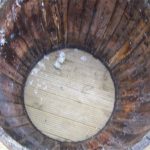We may receive a commission when you use our affiliate links. However, this does not impact our recommendations.

As the finish was drying yesterday on my double-screw vise, I took a few minutes to turn a new handle for my bench screw, which pierces my crochet (which sounds dirty, but isn’t really).
The handle began life as an octagon that I planed down to 1-1/2″ square in section. Then I turned the post down to 1″ in diameter and threaded it.
The pad is not Moxon-approved equipment. My original screw would tend to mar the work if I tightened it down too far, so I decided to add a leather-faced pad that works like an F-style clamp. The pad spins until it comes in contact with something. Then it stops as the screw is tightened on the work.
I made a short video that explains this better than my words.
This screw is also a little shorter in length than the previous one. Before you ask, I did no harm to my soft parts on the previous one. But I didn’t need the extra length (sounds dirty , isn’t) so I shortened it.
– Christopher Schwarz
Other Workbench Sources I Recommend
– “Workbenches: From Design & Theory to Construction & Use” by Christopher Schwarz
– CD “The Best of Shops & Workbenches” from Popular Woodworking Magazine
Here are some supplies and tools we find essential in our everyday work around the shop. We may receive a commission from sales referred by our links; however, we have carefully selected these products for their usefulness and quality.








I agree with Dean on this one. I believe the screw acts as a third hand to hold a long board while you set the deadman in place. The wedge or stepped action of the cleavis stops the forward motion while planing.
How did you attach the pad? I noticed what looks like a piece of leather on the face. Once the pad is in place I assume the screw won’t back out. Did you make it in two pieces and glue it together in place?
Yes, but I don’t have to build a new belt….
What I like about the screw has more to do with holding stuff for joinery rather than edge planing. I have a heck of a time getting the holdfast in the right place. The screw thingy is faster and easier (for me).
My take on this is you’ve got a belt-and-suspender situation. If you look at the single screw in Moxon & Holme (and in Holme in particular) you’ll see that the crochet is "stepped" rather than the long wedge shape you have. In the case of a crochet with steps I see the value of the single screw, it keeps the board from tipping in the crochet. In your case (and on my bench) the crochet wedges the board against the bench when you apply any forward force, no need to add a screw to slow you down.
Now, if you are going to use the single screw to hold a board in place when you aren’t going to have a load directed into the crochet I can see the use even in a wedged shaped crochet. But, at that point holdfasts in the apron, or that fancy new twin-screw vise is a good option…
Chris,
Great job. All of this historical information being brought up to date and put into use really helps me grasp how the work got done back in the day.
Thanks,
Mike
Nice, Chris. Appreciate the video too.
One more thing…how do YOU know what it sounds like to hit a mouse with a mallet ! LOL!
I guarantee you will hurt yourself at some point. I hope you and the Mrs. are finished with having kids.
What’s the difference if you left the screw out of the crochet and relied on the holdfasts alone to keep the wood secure? Is it more secure or faster to work?
Good stuff: Although — at what point does this become a triangular shoulder vice?
Or is it a twofer — a planing stop/crochet that **also** can serve as a shoulder vice?
–GG